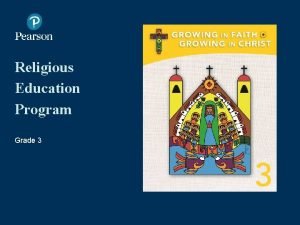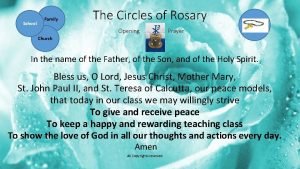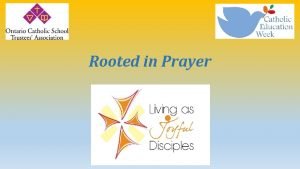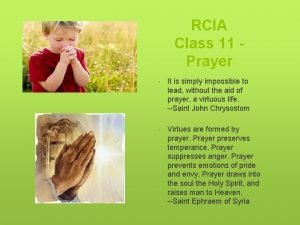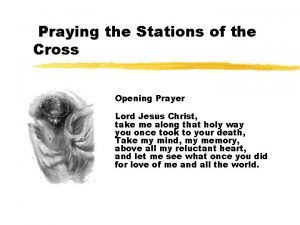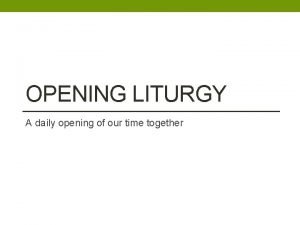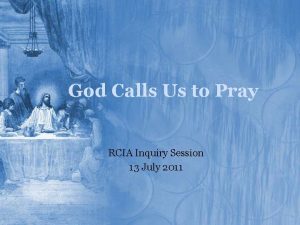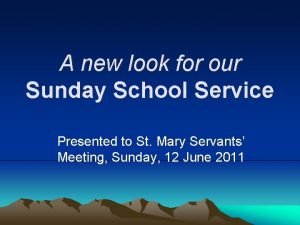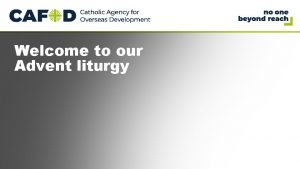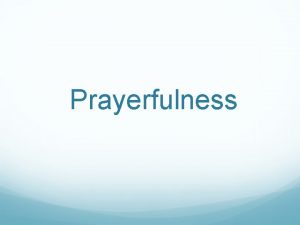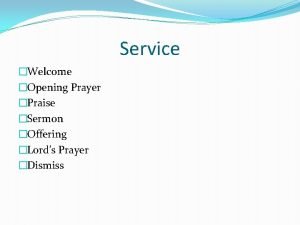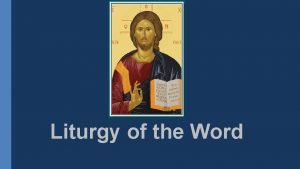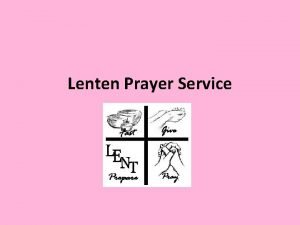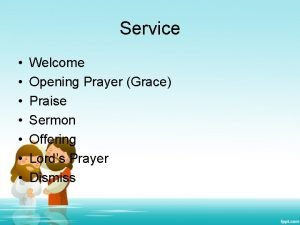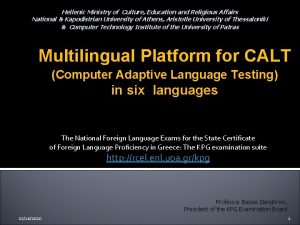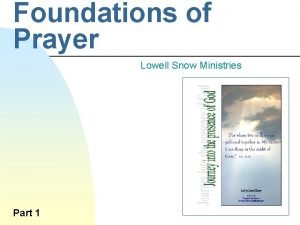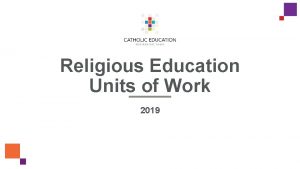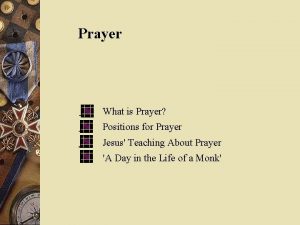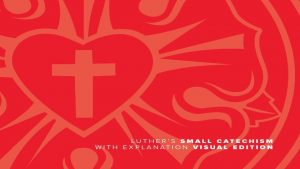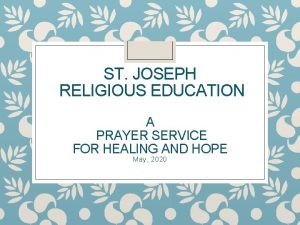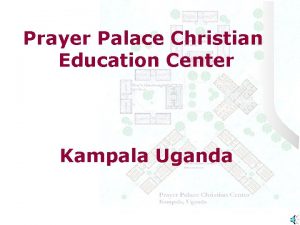Religious Education Program Grade 3 1 Opening Prayer





































- Slides: 37

Religious Education Program Grade 3 1

Opening Prayer 2

Theological Emphases—Key Documents 3

Growing in Faith, Growing in Christ— Key Documents 4

Knowledge of the Faith—Believing Promoting Liturgical Education— Celebrating Teaching to Pray—Prayer Relationship with Jesus Moral Formation— Living a Moral Life Missionary Initiation— Solidarity Education for Community Life—Living in Communion 5

The Six Strands (ML) (CL) (BL) (LC) (LS) (PR) 6

Growing in Faith, Growing in Christ creates strong links between home, school, and parish. The classroom experience helps students to deepen their love of God and their neighbours. Using the best pedagogical practices, the program seeks to engage students in knowing and living their faith. This will not only help them today, but will also prepare them for tomorrow as they grow and mature and make significant contributions to our society as faith-filled Catholics who radiate the joy of believing. The Assembly of Catholic Bishops of Ontario The Catholic Bishops of Alberta The Catholic Bishops of Saskatchewan The Catholic Bishops of the Northwest Territories 7

The New Evangelization Religious Education is part of the Church’s evangelizing mission. The New Evangelization targets Catholics who have fallen away from the Church for one reason or another. This new initiative re-proposes, not imposes, Jesus Christ and His Gospel to the baptized. The hope is that this new mission will lead to the conversion of the baptized. You may ask yourself, “What is ‘new’ with the New Evangelization? ” The Church has called for new ardour, methods, and expressions in our evangelizing efforts. The New Evangelization encourages knowing Jesus Christ as a person, not as an idea. As a teacher, you are called to be an evangelist in your classroom. Using your actions (witness) and your words (proclamation), you reveal Christ to your students on a daily basis. It is my hope that you will use the Growing in Faith, Growing in Christ program to support the Church’s evangelizing efforts. Sincerely, Dr. Josephine Lombardi Growing in Faith, Growing in Christ Program Theologian 8

Growing in Faith, Growing in Christ resources support the Religious Education Policy Document at School, at Home, and in the Parish. • Engaging readings and activities support the teachings of the Catholic Church • Print resources are adapted for 21 st century learning • Extensive support for students, teachers, parents/caregivers, and pastoral teams • Authentic Assessment and Evaluation that follows the Ontario Growing Success document • Awareness of the local and historical Church in Canada • Developed by Canadian religious educators, First Nations, Inuit, and Métis reviewers, theologians, Catholic teachers in Canadian context • Learning cycle helps students relate faith content to their own lives • Resources support connections to faith lived in the home, school, and parish throughout the liturgical year 9

Assessment in Growing in Faith, Growing in Christ • Supports educators as they gather evidence of learning of the Grade 3 Religious Education expectations • Provides explicit examples of opportunities for assessment in each unit and lesson • Reflects best practice in classroom assessment • Includes an inquiry task that provides an opportunity for assessment of learning at the end of each unit Assessment for Learning: Best Practice • Students are provided with multiple opportunities to represent their thinking in a variety of ways: e. g. , drawing, role-playing, drama, writing, and music • Careful observation of students engaged in the learning process provides insight into a student’s knowledge, understanding, and skills. • Frequent conversations between teachers and students open a window into what a student is thinking and learning. These conversations also allow for the teacher to give feedback and provide the next steps for learning. • Student self-assessment and reflection on learning is an integral part of assessment for and as learning. 10

Series Organization • Each grade (1– 8) is organized into five units, which follow the course of the liturgical and school year • Starting in grade 3, student book units are grouped into chapters, which correlate to the lessons in the teacher resource • Each unit has between 5 and 11 lessons • Each lesson is divided into four Days (parts) • Expectations are grouped within lessons; all expectations are addressed 11

Grade 3 and EQAO • The Ontario Catholic Elementary Curriculum Policy Document for Religious Education, Grade 1 -8 states that religious education in schools is a scholastic discipline with the same systematic demands and the same rigour as other disciplines. • Teaching and learning in the program involve a variety of strategies that are centred in language literacy. Growing in Faith, Growing in Christ also attends to the crosscurricular connections from The Ontario Curriculum, Grades 1– 8: Language, 2006 and links activities in the teaching notes to those expectations. 12

Grade 3 and EQAO—Examples Skills Assessed on EQAO How Growing in Faith, Growing in Christ Supports EQAO Reading: understanding implicitly stated information and ideas (making inferences) use of simplified language in retelling or explaining Bible stories to enable understanding Writing: developing a main idea with sufficient supporting details; organizing information and ideas in a coherent manner chunking content into smaller segments to promote understanding and allow for better responses to questions 13

Grade 3 Program Components Overview • • • Student School and Home Resource (260 pages) Comprehensive Teacher Resource 24 posters 14

Grade 3 Digital Content – Print Implementation For Boards with print implementation, multimedia content available on CDs includes: • Songs with instrumental tracks, lyrics, and scores • Line masters • Front and back matter • Image Gallery 1 5

How Grade 3 Differs from Grades 1 and 2 • • • The Student Book and Posters cover all curriculum expectations with reinforcement in the Teacher Resource Units have been divided into chapters Pedagogy explicit in the Student Book: • Unit Opener introduces students to a unit inquiry question, key learnings, and a unit inquiry task • Unit Closer revisits the inquiry question, key learnings, and unit inquiry task, allowing students to demonstrate their learning by completing the task Check Your Learning questions reinforce students’ understanding of a chapter’s content My Faith Journey questions inspire self-reflection regarding students’ own growing faith Growing in Faith end-of-chapter questions prompt students to reflect on the key learnings in the chapter 16

Student Book Features Unit Opener ✓ Let’s Explore * ✓ Intro to Unit Inquiry Task ✓ Chapter Opener ✓ We Read the Bible ✓ Story Narratives ✓ Scripture and Gospel Retellings ✓ Profiles of Saints and Holy People ✓ Faith Facts ✓ Faith in Action ✓ * denotes assessment features Our Catholic Faith ✓ Why We Pray ✓ What We Believe ✓ How We Celebrate ✓ How We Live ✓ At Home ✓ My Faith Journey * ✓ In the Parish ✓ Check Your Learning* ✓ Growing in Faith * ✓ Unit Closer ✓ Show What You Know * ✓ Unit Inquiry Task * ✓ 17

From Unit Opener to Unit Inquiry Task 18

Student Book Features 19

Student Book Features 20

Student Book Features 21

Student Book Features 22

Student Book Features 23

Student Book Features 24

Teacher Resource Features Unit Components ✓ Unit Introduction ✓ Unit Planning and Preview Chart ✓ Key Assessment Opportunities* ✓ Using the Unit Opener ✓ Preview the Unit Inquiry Task * ✓ The Mission of Our Catholic Community: Joyful in Our Journey ✓ Using the Unit Closer * ✓ Unit Inquiry Task * * denotes assessment features Lesson Components ✓Focus Question ✓ 4 -Day Classroom Planner (Chart) * ✓Lesson Learning Focus * ✓Curriculum Connections * ✓A Moment of Reflection ✓Informing your Faith and Preparing to Share Your Faith ✓Four-Day Plan (Day 1: Get Started, Day 2: Explore Our Faith, Day 3: Explore Our Faith, Day 4: Make It Your Own) * ✓ Introducing the Chapter ✓ Growing in Faith * 25

Teacher Resource Features Margin features that support effective practice • • • Faith Vocabulary/Terminology Curriculum Connections (Language, Social Studies, Arts, Physical and Health Education, and so on) Technology Opportunity Inquiry Opportunity Assessment Opportunity Differentiated Instruction Responding to Sensitive Topics Teaching Tip In the Parish At Home with Family 26

Combined Grades Support 27

Beginning a Lesson… 28

Success Criteria: “I Can” statements 29

Cross-curricular Connections 30

Faith Information 31

The Prayer Centre 32

Day 1– 4 Plan Overview 33

Day 1– 4 Plan Overview 34

Day 1– 4 Plan Overview 35

Poster Pack • Helps create a faith-based environment in the classroom including liturgical calendar, prayers, and Catholic symbols 36

Website Extras www. pearsoncan ada. ca/growinginf aith 37
 Opening prayer for religious education
Opening prayer for religious education Prayer for school opening
Prayer for school opening Opening prayer for class
Opening prayer for class Opening prayer for meeting
Opening prayer for meeting Opening prayer for catechism class
Opening prayer for catechism class Opening prayer stations of the cross
Opening prayer stations of the cross Ancestor prayer
Ancestor prayer Closing prayer for meeting
Closing prayer for meeting Closing prayer
Closing prayer Prayer of adoration
Prayer of adoration Opening prayer for confirmation class
Opening prayer for confirmation class Opening prayer for christmas party
Opening prayer for christmas party Prayer for discipleship catholic
Prayer for discipleship catholic Opening prayer for sunday service
Opening prayer for sunday service Opening prayer for catechism class
Opening prayer for catechism class Closing prayer for class
Closing prayer for class Opening prayer
Opening prayer Facilitation sur zoom
Facilitation sur zoom Xxx o my god
Xxx o my god Opening prayer for meetings
Opening prayer for meetings Opening prayer for praise and worship
Opening prayer for praise and worship Opening prayer for sermon
Opening prayer for sermon Opening prayer introduction
Opening prayer introduction Prayer for final defense
Prayer for final defense Opening prayer for wedding
Opening prayer for wedding Praye r
Praye r Unison prayer
Unison prayer Prayer meeting
Prayer meeting Alive o 4 songs
Alive o 4 songs Opening prayer
Opening prayer Opening prayer for lent
Opening prayer for lent Sermon opening prayer
Sermon opening prayer Opening prayer for training session
Opening prayer for training session Hellenic ministry of education and religious affairs
Hellenic ministry of education and religious affairs Prayer topics
Prayer topics Act of confession
Act of confession Prayer guide: a manual for leading prayer lowell snow
Prayer guide: a manual for leading prayer lowell snow Animism africa
Animism africa
